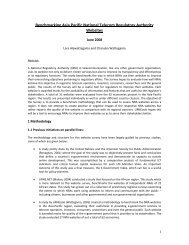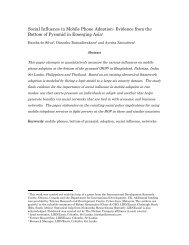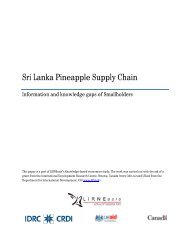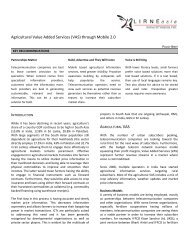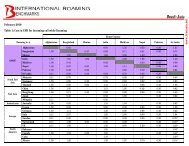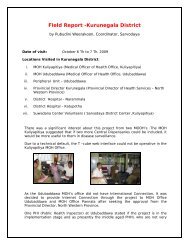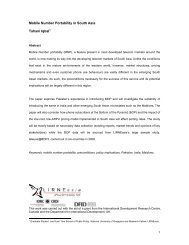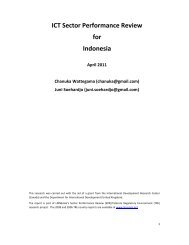Teleuse@BOP3: A Qualitative Study - LIRNEasia
Teleuse@BOP3: A Qualitative Study - LIRNEasia
Teleuse@BOP3: A Qualitative Study - LIRNEasia
You also want an ePaper? Increase the reach of your titles
YUMPU automatically turns print PDFs into web optimized ePapers that Google loves.
is currently using to track her boyfriend’s whereabouts for similar reasons of suspicion. Ronnie’s is currently tracking<br />
her husband through the service.<br />
In other discussions it can be seen how textmate relationships have further evolved into marital bonds and how some<br />
couples seem to be comfortable with the ideas of their spouse having textmates as long as the relationships were<br />
textual. It would be interesting to track the development of the ‘textmate phenomena’ to understand its impact on<br />
gender usage in future.<br />
Age<br />
Age has emerged as a significant variable in tele adoption and use in most countries except Philippines. Phone use<br />
patterns and technology readiness are quite similar in all the four South Asian countries within the age groups of 15-<br />
25 years in male respondents.<br />
The average age for mobile ownership in the BOP from our sample, is about 22 years for male in South Asia and 24<br />
for women. Men, however, have far longer experiences around phone use, having used the phones of friends and<br />
other family members for more than four years on average. While men have a much longer experience of using and<br />
sharing phones, many of them are emerging as late buyers (considering the age from which they start use) since<br />
purchasing one’s own handset requires investments made from one’s own earning.<br />
Women, on the other hand, are both late users and owners, largely because they are receiving their first handsets<br />
from male family members, at least after two years of the first purchase of the device. Unlike men, who have a longer<br />
experience of using the phones, women have minimal to no experience, prior to acquiring their phones. The minimal<br />
exposure is available mostly to housewives who may talk with their family members with the numbers being dialed<br />
for them or at most they make the calls themselves with permission. Listening to music is also partially prevalent in<br />
women as a part of their phone use when they are non-owners, but it is not seen widely. It is only when the mobile<br />
phone becomes a home phone or is specifically allotted to them that women actually begin to explore the device and<br />
the functions that it can perform.<br />
Vis-à-vis the younger age group, it is observed that children are using the phones of their parents more and more.<br />
This is specifically true for the male child. We saw several instances of boys of 10-12 years of age in Sri Lanka,<br />
Pakistan, Bangladesh, Thailand and India, helping their parents in using their phones and using the same phones to<br />
interact with their friends as well. The earliest case of such usage was in Bangladesh where the parents being above<br />
45 years of age, their son who is 8 years old, was helping them use the phone. As a result, we are seeing a situation<br />
where the higher the age of the senior mobile user in the household, the younger is the age of the child who assists<br />
41




